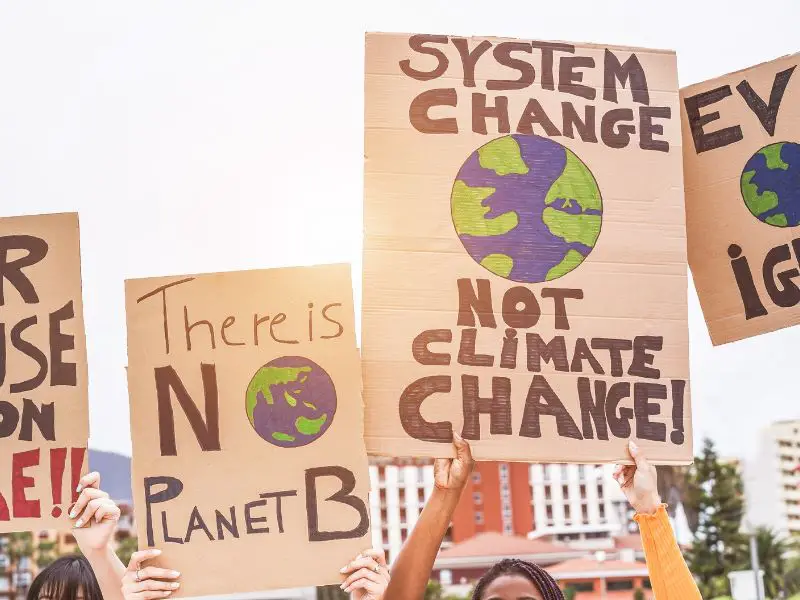Today, we’ll take a look at the problem of climate alarmism.
Many discussions about climate change are going on, but most are very harmful and full of doom and gloom.
People often say things like “billions of lives will be lost” and “the world will end in X years” to stress how important it is to do something about climate change. Images of wildfires destroying whole towns and storms obliterating entire neighborhoods dominate the center stage. However, some experts believe such debates are detrimental to our mental health and we must deal with these changes.
Earth’s Doom and Gloom Cause Eco-Anxiety
As for American Psychiatric Association, eco-anxiety is defined as:
“The chronic fear of environmental disaster that comes from observing the seemingly irrevocable impact of climate change and the associated concern for our future.”
Gen Z and Millenials are becoming more aware of the harmful implications of climate change on the environment and human health. Still, this awareness is often accompanied by solid emotive reactions, such as psychological discomfort, rage, or despair. The phrase eco-anxiety refers to experiencing substantial “negative” emotions such as concern, remorse, and pessimism in anticipation of climate change.

Climate Alarmist vs. Climate Alarming
There is no doubt that we’ve carved ourselves a bottomless hole in climate change. However, an increasing number of experts oppose fearmongering, seeing that it magnifies mental health difficulties and fears rather than spurring action.
The topic of climate change is divided between the sense of alarm and alarmism. There is a growing gap between the vocabulary used by green groups to promote action on the issue and the terminology used by climate scientists to explain climate change. Scientific discoveries were often overstated to attract people’s attention and provoke an emotional reaction.
Another issue is that some people often know just half of the story, which may be more upsetting than the facts themselves. Leslie Davenport, a therapist and the author of a workbook that helps children process climate change, suggested that children frequently hear information from the radio or television, research the subject on their own, and then start having negative emotional responses since they can’t process their thoughts and emotions about it.
How You Can Face the Harsh Reality of Climate Change
There are various ways to cope with the anxiety about the danger posed by climate change.
1. Recognize and Validate Your Emotions
It’s important to reassure ourselves that it’s normal to feel the way they do before we can discuss potential remedies. When you acknowledge your feelings of worry or anger, you send a message that you hear them and care about what they have to say. According to the Australian Psychological Society (APS), ignoring or rejecting the climate issue might hurt the mental health of people experiencing climate anxiety.
2. Do Something to Reduce Your Worry
Taking the time to listen to your own worries about climate change can make you feel more hopeful, strong, and confident. You need to know that even small things you do can make a big difference.

Anxiety stems from emotions of uncertainty and helplessness. So, gaining some feeling of control is an excellent approach to feeling less worried. Dr. Patrick Kennedy-Williams, an Oxford University clinical psychologist, believes that the greatest method to combat climate change is to take action. It’s all about taking action to help.
- Advocate for change: You can be an advocate of change by writing to politicians, signing petitions, and participating in protests and rallies – as long as you approve.
- Recycle: You can start recycling at home by separating your trash into paper, plastic, metal cans, glass, etc. You can also encourage your social circle to recycle. This reduces pollution and creates awareness of how our actions can impact the environment around us. Even simple things can help, like buying reusable grocery bags or straws instead of disposable ones.
- Be more environmentally friendly: You can follow eco-friendly practices such as turning the lights off when leaving the room and not leaving electronics plugged in all the time. You can plant trees and flowers in their backyards and grow their vegetables- all of which are great ways to start making a difference in the environment. There are thousands of small ways to reduce carbon emissions! It’s just a matter of finding something that you are passionate about.
3. Regularly Take a Break From the News and Social Media
We are, after all, just human. Therefore, it is essential to remind ourselves that it is OK to take pauses from worrying about climate change to relax, have fun, or engage in activities we like. This may include shutting off electronics and social media platforms. Sometimes we need a break from how awful the world might appear, and to save energy for action, we must create room in our lives for other pursuits.
4. Call for Change and Speak Out
Call for change, speak out about climate change, and instill confidence in people that they can make a difference. Encourage people to be hopeful about the future; even if the planet gets destroyed in ten years, thousands of others will inherit it, and it will be rebuilt again – which is a beautiful thing! It is OK to have hope because it keeps us going – it makes us human!

Author’s Note About Climate Alarmism
While the media portrays images of impending doom caused by global warming on a grand scale, the reality is that smaller steps taken by everyone can help save the planet and prevent catastrophic disasters in the future. Moreover, it is essential to understand that we have the power to impact the future of our world by simply changing our daily habits.


3 thoughts on “Defining Climate Alarmism & Taking Action to Prevent It”